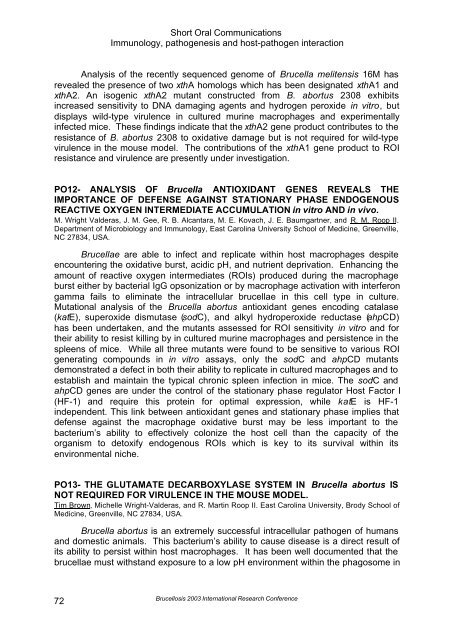Brucellosis 2003 proceedings - PHIDIAS
Brucellosis 2003 proceedings - PHIDIAS
Brucellosis 2003 proceedings - PHIDIAS
Create successful ePaper yourself
Turn your PDF publications into a flip-book with our unique Google optimized e-Paper software.
Short Oral Communications<br />
Immunology, pathogenesis and host-pathogen interaction<br />
Analysis of the recently sequenced genome of Brucella melitensis 16M has<br />
revealed the presence of two xthA homologs which has been designated xthA1 and<br />
xthA2. An isogenic xthA2 mutant constructed from B. abortus 2308 exhibits<br />
increased sensitivity to DNA damaging agents and hydrogen peroxide in vitro, but<br />
displays wild-type virulence in cultured murine macrophages and experimentally<br />
infected mice. These findings indicate that the xthA2 gene product contributes to the<br />
resistance of B. abortus 2308 to oxidative damage but is not required for wild-type<br />
virulence in the mouse model. The contributions of the xthA1 gene product to ROI<br />
resistance and virulence are presently under investigation.<br />
PO12- ANALYSIS OF Brucella ANTIOXIDANT GENES REVEALS THE<br />
IMPORTANCE OF DEFENSE AGAINST STATIONARY PHASE ENDOGENOUS<br />
REACTIVE OXYGEN INTERMEDIATE ACCUMULATION in vitro AND in vivo.<br />
M. Wright Valderas, J. M. Gee, R. B. Alcantara, M. E. Kovach, J. E. Baumgartner, and R. M. Roop II.<br />
Department of Microbiology and Immunology, East Carolina University School of Medicine, Greenville,<br />
NC 27834, USA.<br />
Brucellae are able to infect and replicate within host macrophages despite<br />
encountering the oxidative burst, acidic pH, and nutrient deprivation. Enhancing the<br />
amount of reactive oxygen intermediates (ROIs) produced during the macrophage<br />
burst either by bacterial IgG opsonization or by macrophage activation with interferon<br />
gamma fails to eliminate the intracellular brucellae in this cell type in culture.<br />
Mutational analysis of the Brucella abortus antioxidant genes encoding catalase<br />
(katE), superoxide dismutase (sodC), and alkyl hydroperoxide reductase (ahpCD)<br />
has been undertaken, and the mutants assessed for ROI sensitivity in vitro and for<br />
their ability to resist killing by in cultured murine macrophages and persistence in the<br />
spleens of mice. While all three mutants were found to be sensitive to various ROI<br />
generating compounds in in vitro assays, only the sodC and ahpCD mutants<br />
demonstrated a defect in both their ability to replicate in cultured macrophages and to<br />
establish and maintain the typical chronic spleen infection in mice. The sodC and<br />
ahpCD genes are under the control of the stationary phase regulator Host Factor I<br />
(HF-1) and require this protein for optimal expression, while katE is HF-1<br />
independent. This link between antioxidant genes and stationary phase implies that<br />
defense against the macrophage oxidative burst may be less important to the<br />
bacterium’s ability to effectively colonize the host cell than the capacity of the<br />
organism to detoxify endogenous ROIs which is key to its survival within its<br />
environmental niche.<br />
PO13- THE GLUTAMATE DECARBOXYLASE SYSTEM IN Brucella abortus IS<br />
NOT REQUIRED FOR VIRULENCE IN THE MOUSE MODEL.<br />
Tim Brown, Michelle Wright-Valderas, and R. Martin Roop II. East Carolina University, Brody School of<br />
Medicine, Greenville, NC 27834, USA.<br />
Brucella abortus is an extremely successful intracellular pathogen of humans<br />
and domestic animals. This bacterium’s ability to cause disease is a direct result of<br />
its ability to persist within host macrophages. It has been well documented that the<br />
brucellae must withstand exposure to a low pH environment within the phagosome in<br />
72<br />
<strong>Brucellosis</strong> <strong>2003</strong> International Research Conference
















